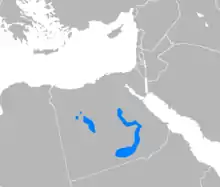Saʽidi Arabic
Ṣaʽīdi Arabic (autonym: صعيدى [sˤɑˈʕiːdi], Egyptian Arabic: [sˤeˈʕiːdi]), also known as Upper Egyptian Arabic,[3] is a variety of Arabic spoken by the Ṣaʽīdi people (Upper Egyptians) in Upper Egypt, a strip of land on both sides of the Nile river that extends between Nubia and downriver (northwards) to Lower Egypt.[4] It shares linguistic features with both Egyptian Arabic and the Quran's Classical Arabic. Dialects include Middle and Upper Egyptian Arabic.[5]
| Saʽīdi Arabic | |
|---|---|
| صعيدى | |
| Native to | Egypt |
Native speakers | 22.4 million (2016)[1] |
Afro-Asiatic
| |
| Arabic alphabet | |
| Language codes | |
| ISO 639-3 | aec |
| Glottolog | said1239 |
| Linguasphere | 12-AAC-eb[2] |
 | |
Speakers of Egyptian Arabic do not always understand more conservative varieties of Ṣaʽīdi Arabic.[6]
Ṣaʽīdi Arabic carries little prestige nationally, but it continues to be widely spoken in the South, and in the north by Southern migrants who have also adapted to Egyptian Arabic. For example, the Ṣaʽīdi genitive exponent is usually replaced with Egyptian bitāʿ, but the realisation of /q/ as [ɡ] is retained (normally realised in Egyptian Arabic as [ʔ]).
Saidi Arabic has various sub-dialects and varies widely from a town to town. Because of the tribal nature of Upper Egypt, and because some of the Upper Egyptian tribes have had links to Hejaz, or even the Maghreb, traces of Hejazi Arabic, and Libyan Arabic could be vividly noticed in many sub-dialects. For example the word "قعمز" meaning "sit", is used throughout the Maghreb and continues to be widely used in Upper Egypt. Furthermore, in addition to similar pronunciation of letters with Hejazi cities such as Jeddah and Mecca, words such as "لسع" meaning "still" and "قمرية" meaning "wild pigeon" are in wide use in Upper Egypt. Other examples are classical words such as "فروج" meaning "chicken", as opposed to "فرخة" that is used in Northern Egypt.
Second- and third-generation Ṣaʽīdi migrants are monolingual in Egyptian Arabic but maintain cultural and family ties to the south.
The Egyptian poet Abdel Rahman el-Abnudi wrote in his native Sa'idi dialect and was the voice of the 2011 Egyptian Revolution and a prominent Egyptian Nationalist.
Phonology
References
- "Arabic, Sa'idi Spoken". Ethnologue. Retrieved 2018-08-08.
- "a" (PDF). The Linguasphere Register. p. 128. Retrieved 1 March 2013.
- "Arabic, Sa'idi Spoken". Ethnologue. Retrieved 1 March 2013.
- Versteegh, p. 163
- Orville Boyd Jenkins (2000-03-18). "Population Analysis of the Arabic Languages". Retrieved 2020-06-28.
- Raymond G. Gordon Jr., ed. 2005. Ethnologue: Languages of the World. 15th edition. Dallas: Summer Institute of Linguistics.
- Khalafallah 1969
Sources
- Khalafallah, Abdelghany A. 1969. A Descriptive Grammar of Sa'i:di Egyptian Colloquial Arabic. Janua Linguarum, Series Practica 32. The Hague: Mouton.
- Versteegh, Kees (2001). The Arabic Language. Edinburgh: Edinburgh University Press. ISBN 0-7486-1436-2.
